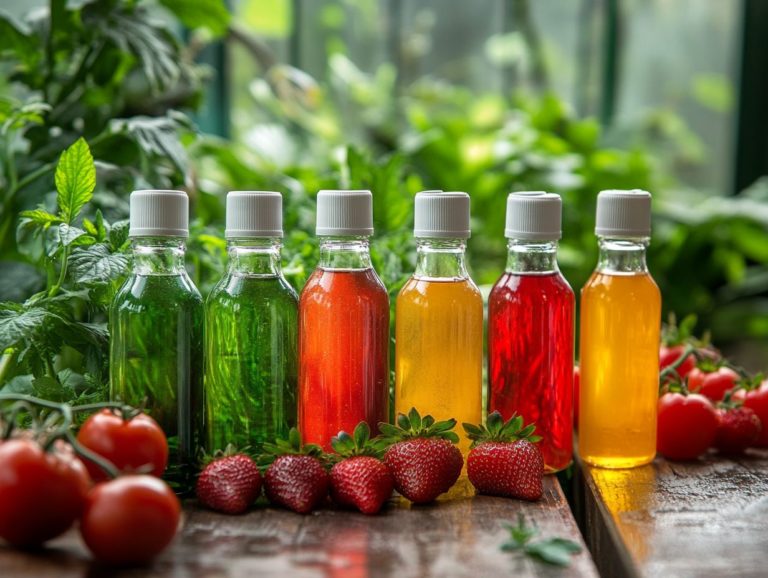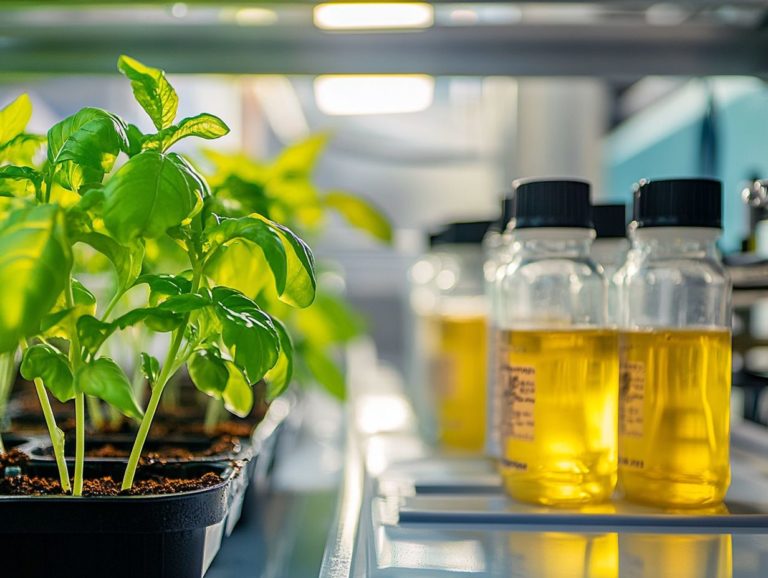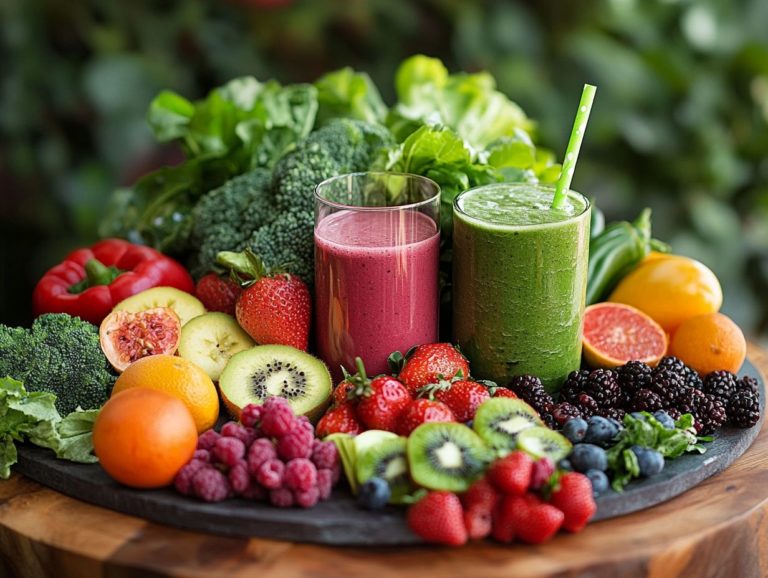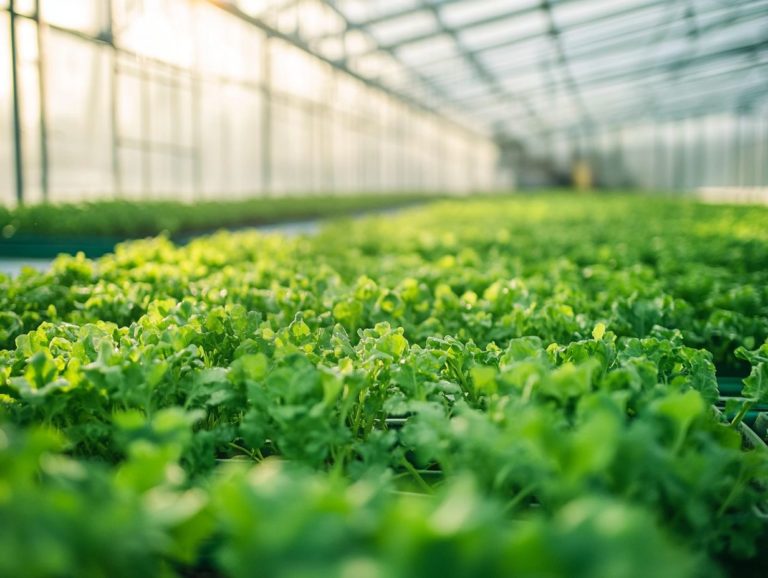Top Hydroponic Systems and Their Nutrient Needs
Hydroponics is revolutionizing plant growth! It provides a soil-free alternative that optimizes both space and resources, making it one of the best hydroponic methods available today.
Dive into the different types of hydroponic systems, from Deep Water Culture to Aeroponics, each offering unique benefits.
Understand the essential nutrients your plants need to flourish, such as nitrogen, phosphorus, potassium, and other vital minerals.
Whether you re a seasoned gardener or just stepping into hydroponic gardening, grasping these systems and their nutrient requirements will empower you to cultivate a thriving hydroponic garden.
Contents
- Key Takeaways:
- Types of Hydroponic Systems
- Key Nutrients for Hydroponic Plants
- Choosing the Right Nutrients for Your System
- Frequently Asked Questions
- What are the top hydroponic systems and their nutrient needs?
- Which hydroponic system is best for beginners?
- Do different plants require different nutrient levels in hydroponic systems?
- How often should nutrient levels be checked in a hydroponic system?
- Can organic nutrients be used in hydroponic systems?
- Are there any common nutrient deficiencies in hydroponic systems?
Key Takeaways:
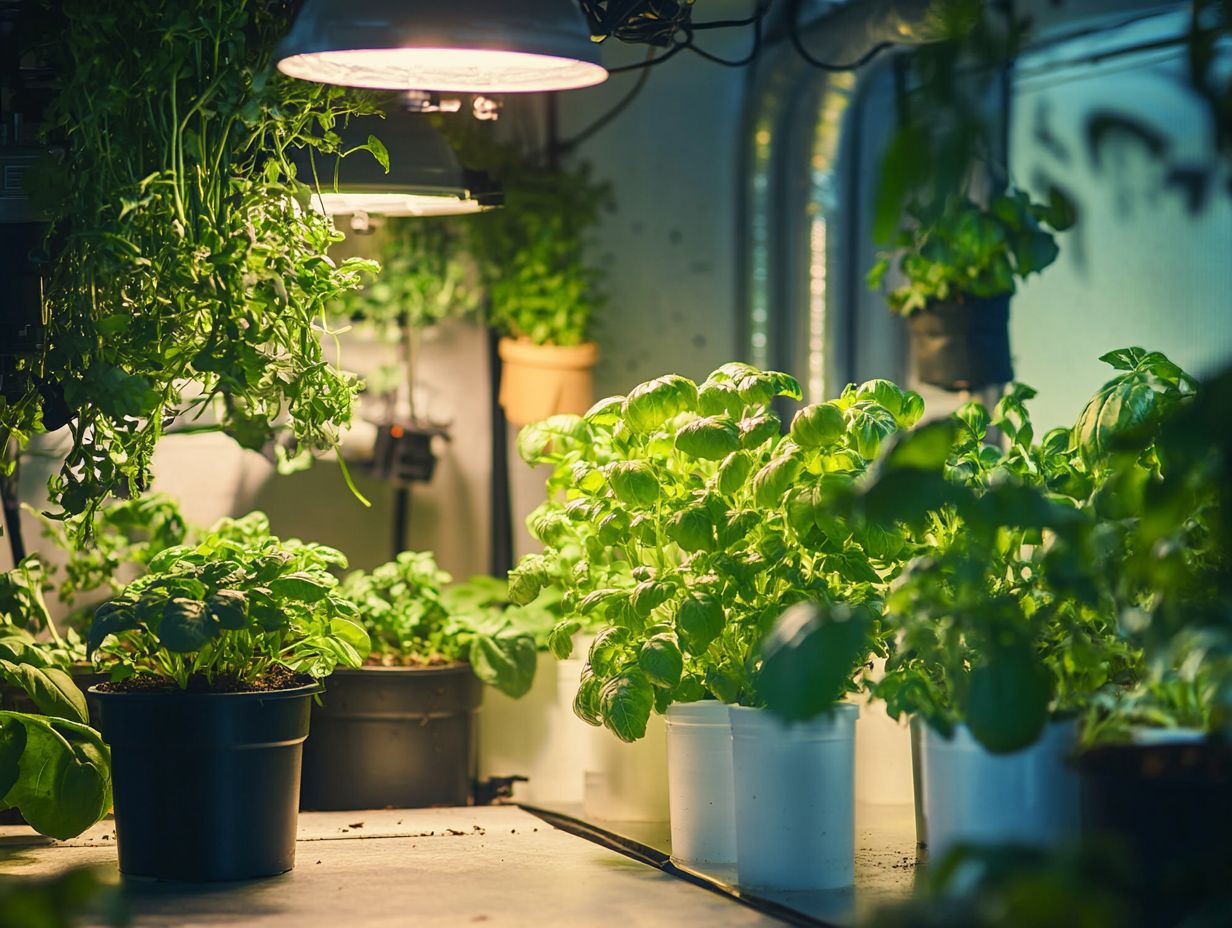
- Hydroponics is a method of growing plants without soil, using water and nutrient solutions.
- The top hydroponic systems include Deep Water Culture, Ebb and Flow, Drip System, and Aeroponics, each utilizing specific nutrient solutions for optimum plant growth.
- Key nutrients for hydroponic plants are nitrogen, phosphorus, potassium, secondary nutrients, and micronutrients. Consider factors such as plant type and growth stage when choosing the right nutrients for your system.
What is Hydroponics?
Hydroponics is a cutting-edge agricultural method that enables you to cultivate plants without the need for soil. Instead, you ll use nutrient solutions that deliver essential nutrients directly to the roots. This innovative approach ensures optimal plant growth by providing a balanced supply of essential nutrients, such as nitrogen and potassium, and vital nutrients, like iron and calcium. This effectively maximizes both development and yield in a controlled environment.
This technique enhances productivity and tackles challenges of traditional soil-based gardening, such as pest control and land degradation. Embracing hydroponics, such as Aeroponics and Ebb and Flow, allows you to grow food in urban settings, reduce water usage, and lessen reliance on chemical fertilizers. All of these contribute to sustainable agricultural practices.
The efficiency in nutrient use means your plants could grow up to 30% faster than those grown in soil, leading to higher crop turnover rates.
In essence, hydroponics offers a versatile solution for food production, enabling communities to thrive while making a positive impact on the environment.
Types of Hydroponic Systems
You ll discover a variety of hydroponic systems meticulously crafted to optimize nutrient delivery and foster robust plant growth. Each system comes with its own set of advantages and challenges in the realm of hydroponic gardening.
Choosing the right system hinges on several factors, including your available space, budget, and the specific plants you wish to cultivate. It’s also essential to ensure the right nutrient balance for each. By carefully considering these elements, you can achieve an effective nutrient balance that paves the way for successful gardening outcomes.
Deep Water Culture (DWC)
Deep Water Culture (DWC) is an incredibly effective hydroponic system. It immerses plant roots in a nutrient solution, giving them direct access to water, nutrients, and oxygen. This method transforms your gardening experience! Watch your plants thrive like never before!
The inner workings of this system revolve around a reservoir filled with a precisely balanced nutrient solution. It’s often aerated using air stones to boost oxygen levels. One standout benefit of DWC is its ability to minimize the risks associated with soil-borne diseases and pests. Understanding what nutrients are essential for hydroponics also offers the potential for quicker growth cycles thanks to the constant supply of nutrients and oxygen.
However, it s not all smooth sailing. You need to manage challenges such as optimal pH levels and water temperature. Preventing root rot is also crucial, especially with issues like nitrogen or magnesium deficiency.
Here are some best practices to tackle these challenges effectively:
- Regularly monitor nutrient concentrations and pH balance
- Implement a proper ventilation system
- Use high-quality air pumps
By adhering to these guidelines, you can cultivate a thriving hydroponic garden that yields bountiful results.
Ebb and Flow (Flood and Drain)
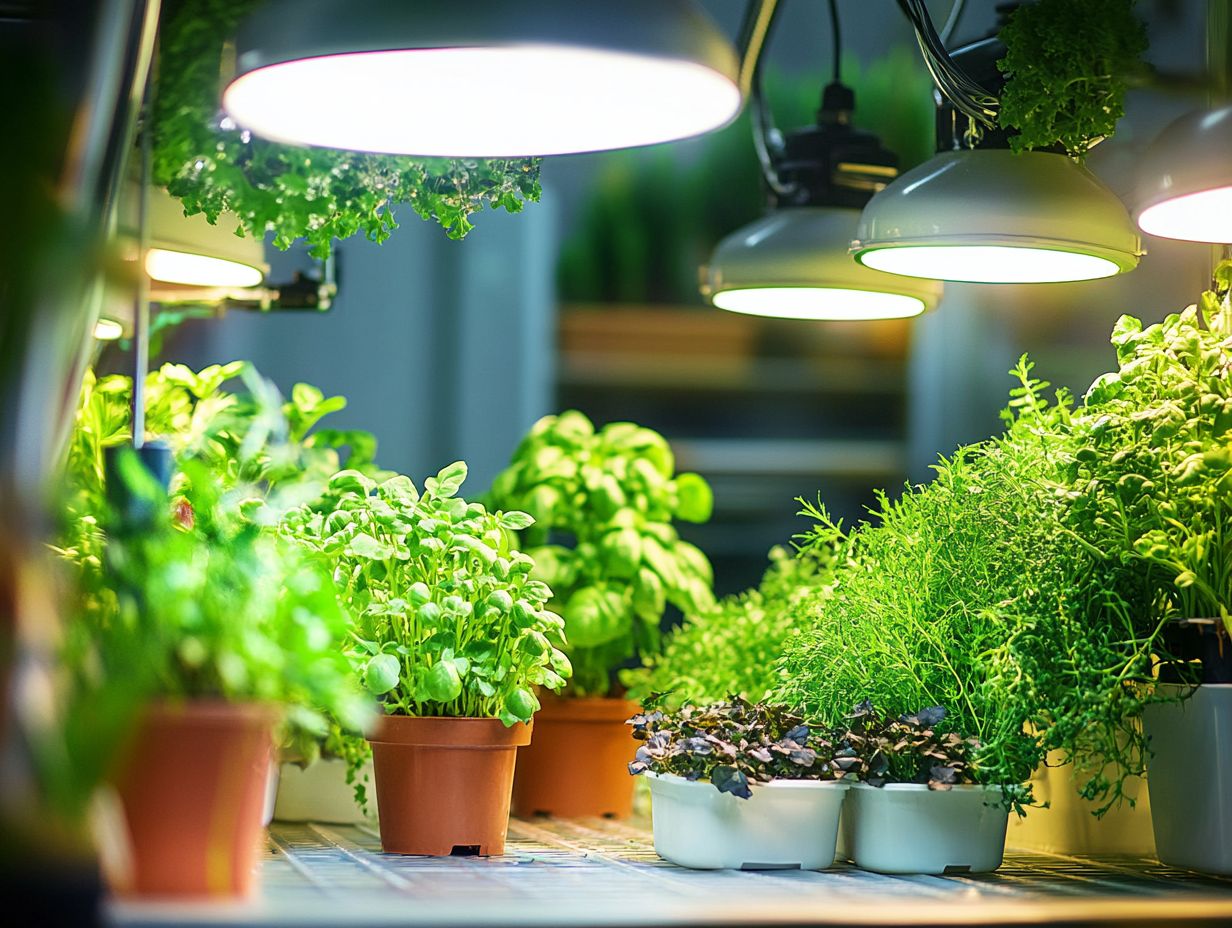
The Ebb and Flow system, often referred to as Flood and Drain, offers a sophisticated hydroponic method. It periodically floods your growing area with nutrient solution before draining it away. This process allows plant roots to absorb vital nutrients and oxygen, fostering healthy growth.
Essentially, this method ensures that your plants receive the nutrients they crave while enjoying the benefits of aeration during the draining phase. To truly elevate the efficiency of your Ebb and Flow setup, grasp the timing and duration of each flood cycle.
By selecting high-quality nutrient solutions specifically designed for hydroponics, you can optimize growth. This provides a perfect balance of essential nutrients needed in large and small amounts. Maintaining proper pH levels and regularly checking water quality are crucial for your plants health.
Drip System
The Drip System is an exceptional hydroponic technique. It delivers a precise amount of nutrient solution directly to the base of each plant, promoting efficient nutrient uptake while minimizing waste.
This method allows you to achieve a perfect nutrient balance, fostering robust plant development. By utilizing a network of tubing and emitters, this system ensures that each plant receives exactly what it needs. For more insights, check out our guide on understanding nutrients for DIY hydroponic systems. It effectively reduces the risk of over-fertilization while maintaining optimal nutrient levels.
To optimize nutrient delivery, it’s essential for you to regularly monitor pH and EC levels. Adjusting the nutrient concentration according to the growth stages of your plants can further enhance nutrient uptake. This technique is a sustainable choice for any modern hydroponic gardening enthusiast, especially when you understand the hydroponic system components.
Aeroponics
Aeroponics is an innovative hydroponic method that allows you to suspend plants in air while misting their roots with a nutrient solution. This provides maximum oxygen exposure and efficient nutrient absorption, promoting rapid plant growth. It’s especially effective for high-density cropping systems.
By utilizing a carefully calibrated mix of nutrients, you can tailor the solution to meet your specific plant needs. This optimizes both growth rates and yields. One of the biggest perks of aeroponics is that it uses less water than traditional farming methods and minimizes the risk of soil-borne diseases. To gain a deeper insight into nutrient management, consider exploring understanding hydroponic nutrient relationships.
Successful implementation requires precise monitoring of environmental factors such as humidity, temperature, and nutrient concentrations, especially when using water-soluble nutrients in your nutrient solutions. For a deeper dive into effective nutrient management, refer to understanding hydroponic nutrient solutions. If you’re venturing into aeroponics, it’s wise to consider the investment in equipment and technology to ensure that your misting system operates effectively and consistently.
Key Nutrients for Hydroponic Plants
Knowing what nutrients your hydroponic plants need is vital for achieving best growth and yield. You need a balanced combination of macronutrients and micronutrients, along with products like Jurassic Veg Booster and Remo Nutrients Combo, to ensure your plants thrive.
These essential nutrients, delivered through a meticulously crafted nutrient solution, play important roles in how plants grow and develop and contribute to overall plant health.
Nitrogen, Phosphorus, and Potassium
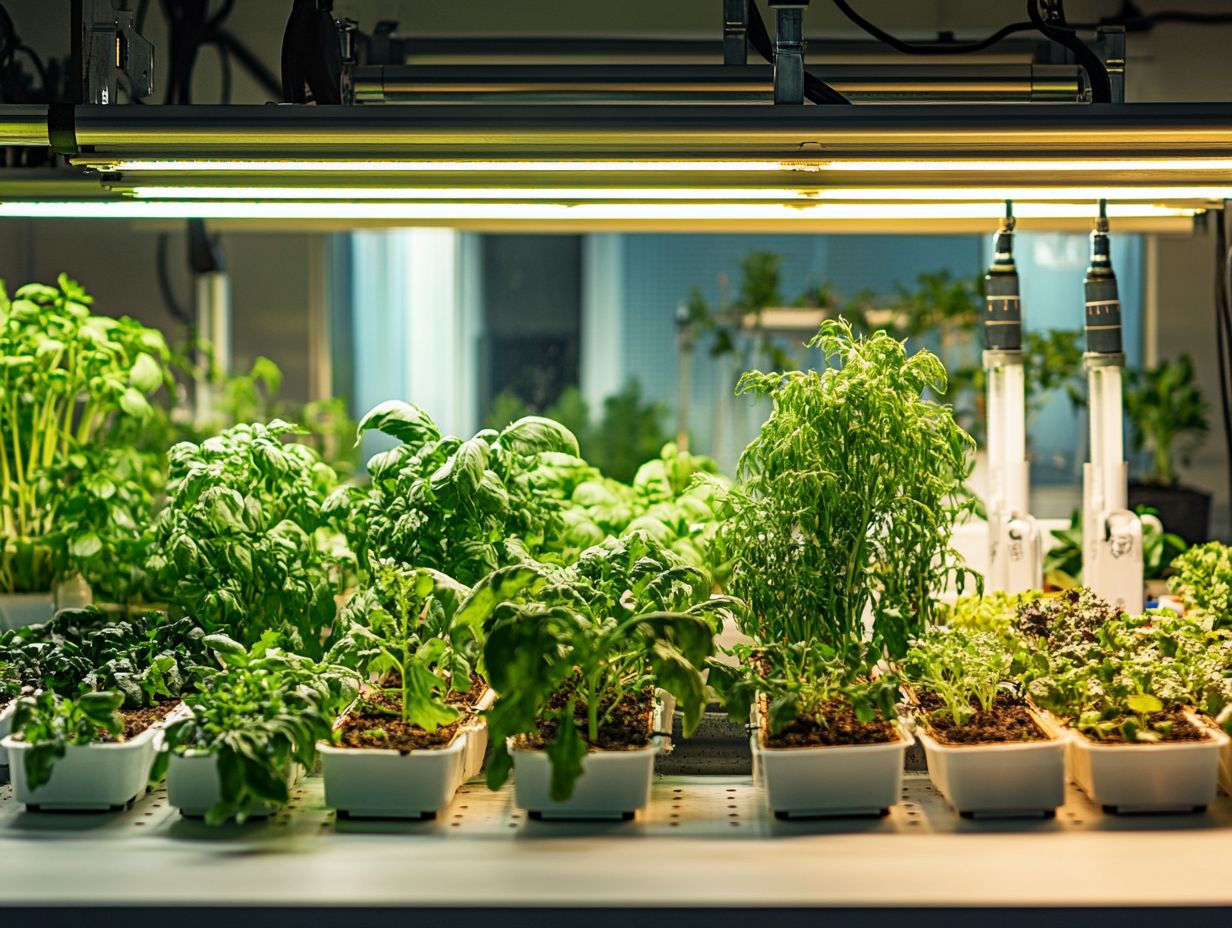
Nitrogen, phosphorus, and potassium commonly known as NPK are the cornerstone macronutrients your hydroponic plants need. Each plays a crucial role in their growth and development. Ensuring a balanced supply of these nutrients is your secret weapon against issues like nitrogen or phosphorus deficiencies, paving the way for robust plant health.
When your plants receive sufficient nitrogen, you’ll notice lush leaf growth, which is vital during the vegetative stage. Phosphorus lays the groundwork for strong root development and flowering, significantly impacting fruit and seed production.
Potassium is the unsung hero, regulating water uptake and enzyme activation both essential for overall plant vigor. An imbalance among these nutrients can spell trouble, leading to stunted growth or poor yields. Too much nitrogen might result in a jungle of foliage at the expense of blooms, while insufficient potassium could leave your plants with weak stems and make them more prone to diseases.
Grasping the delicate balance of NPK in hydroponic systems is crucial for cultivating thriving plants that flourish under your care. Understanding hydroponic nutrient solutions can greatly enhance your gardening success.
Secondary Nutrients and Micronutrients
Along with macronutrients, you should recognize the importance of secondary nutrients and micronutrients like calcium, iron, and magnesium for hydroponic plants. These elements are essential for various biochemical processes and significantly enhance overall plant health. By including them in your nutrient solution, such as those from GreenPlanet Nutrients 4 Part Hydro Fuel Kit, you can prevent deficiencies and bolster plant resilience.
For instance, calcium helps plants grow strong, iron is crucial for making food through photosynthesis, and magnesium plays a vital role in energy transfer.
To effectively integrate these nutrients into your hydroponic system, you may want to use specialized nutrient solutions that maintain balanced concentrations of these elements. Regular monitoring and adjustments are key to ensuring optimal nutrient availability. Imbalances can seriously hinder plant growth, resulting in yield loss and subpar produce quality. By grasping and managing these nutrients, you can cultivate a flourishing hydroponic environment. If you’re looking for efficient setups, consider exploring the top hydroponic systems for small spaces.
Choosing the Right Nutrients for Your System
Choosing the right nutrients is key to helping your plants grow strong and healthy. Considerations such as the type of plant, its growth stage, and the surrounding environmental conditions all play a significant role in determining the appropriate nutrient solution.
This thoughtful approach helps you avert potential nutrient issues, allowing your garden to flourish.
Factors to Consider
When selecting hydroponic nutrients, consider several key factors to optimize plant growth and maintain nutrient balance. Understand the type of plants you re working with, their growth stage, and specific requirements. This informed approach ensures that your nutrient solution effectively nurtures robust plant development.
Understanding the unique nutritional needs of different plant species is crucial. Various types respond differently to nutrient availability. The growth stage of your plants, whether they are in germination, the vegetative phase, or flowering, requires distinct nutrient compositions. For effective management, it’s also beneficial to learn about understanding hydroponic system maintenance. This will influence your choices regarding nitrogen, phosphorus, and potassium ratios.
Also, consider the environmental conditions; pH levels, light intensity, and temperature all play vital roles in nutrient uptake. They significantly affect how efficiently plants absorb those essential components. To truly reap the benefits of hydroponic systems, tailor your nutrient solutions to the specific conditions and requirements of the plants you are cultivating.
Frequently Asked Questions
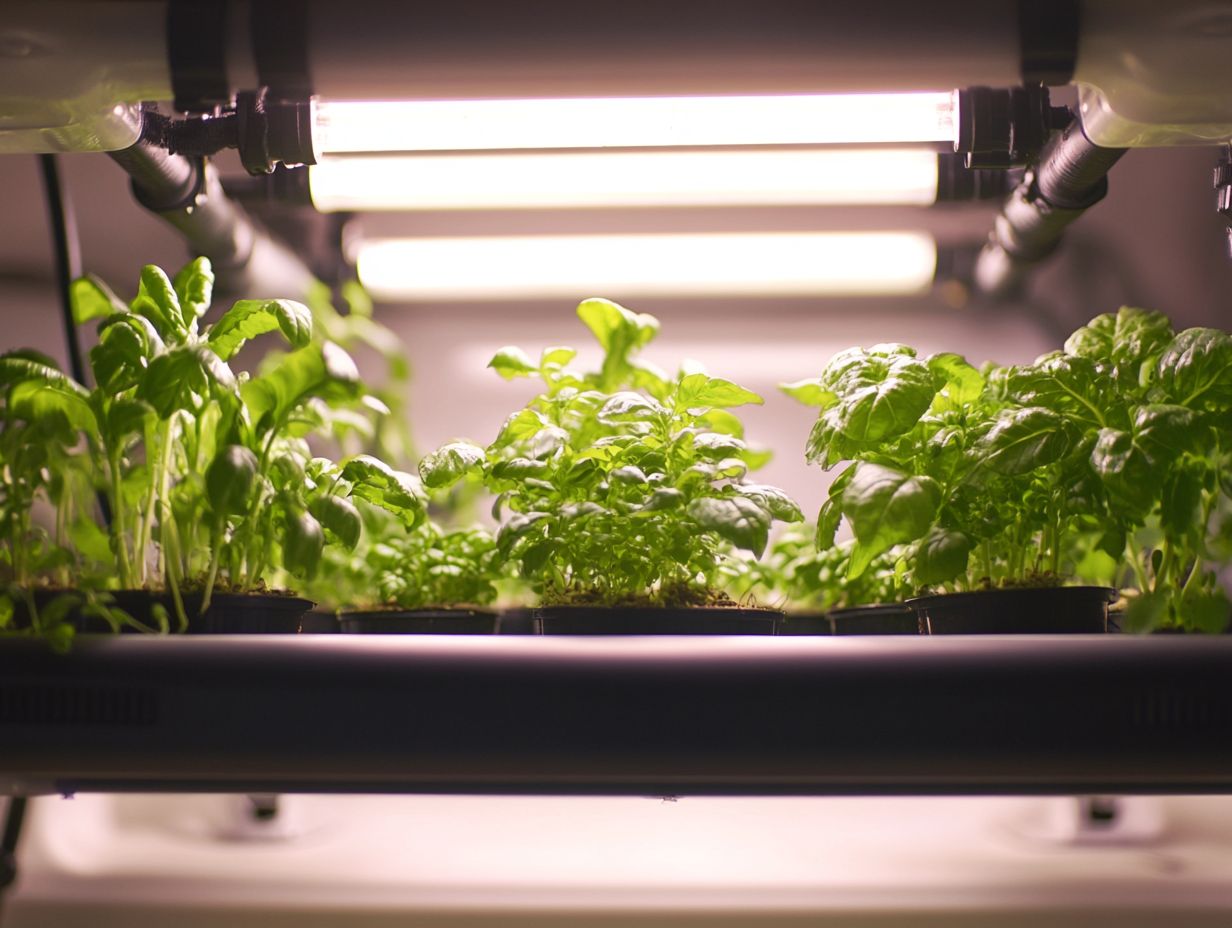
What are the top hydroponic systems and their nutrient needs?
The top hydroponic systems include Deep Water Culture, Ebb and Flow, Drip System, Nutrient Film Technique, Aeroponics, and Wick System. Their nutrient needs may vary but generally consist of a balanced mix of essential nutrients, such as nitrogen, phosphorus, potassium, calcium, and magnesium.
Which hydroponic system is best for beginners?
The Wick System is often considered the easiest and most beginner-friendly hydroponic system. It requires minimal maintenance and is a passive system, meaning it does not need electricity or pumps to function. This makes it a great choice for those new to hydroponics.
Do different plants require different nutrient levels in hydroponic systems?
Yes, different plants have varying nutrient requirements, especially regarding the ratio of nitrogen, phosphorus, and potassium. For example, leafy greens and herbs prefer higher levels of nitrogen, while fruiting plants need more phosphorus and potassium for healthy fruit development.
How often should nutrient levels be checked in a hydroponic system?
Nutrient levels should be checked regularly, ideally once a week. This ensures that the plants have a consistent supply of nutrients and any imbalances can be corrected before they affect plant growth.
Can organic nutrients be used in hydroponic systems?
Yes, organic nutrients can be used in hydroponic systems, but they may require more frequent monitoring and adjustments. Use organic nutrients specifically designed for hydroponics to ensure they are in a form that can be easily absorbed by the plants.
Are there any common nutrient deficiencies in hydroponic systems?
Yes, some common nutrient deficiencies in hydroponic systems include iron, calcium, and magnesium. These can be caused by incorrect nutrient levels, pH imbalances, or poor water quality. Regular monitoring and adjustments can help prevent these deficiencies.
Start your hydroponic journey today!

